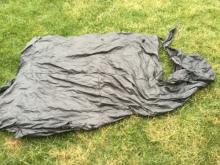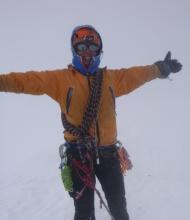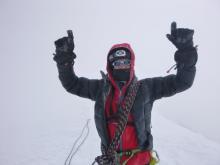DU Professor Survives Scare on Mt. Rainier
Climbers weather 2-day blizzard near summit
It’s hard to miss Brad Davidson in DU’s new engineering and computer science building. The mechanical engineering associate professor is also director of the Human Dynamics Lab and is conducting research for the Knoebel Institute for Healthy Aging. But just six months ago, his life nearly changed forever.
“I never had a ‘we’re not going to make it moment.’ It was scary, but it was never overwhelming,” Davidson says while thinking back to last Father’s Day weekend. It was 3 a.m. on June 17 when Davidson and fellow climber Mark Duggin set out to climb Mt. Rainier in Washington. It was Davidson’s third trip up the mountain.
They started early so they could reach the summit and make it back down before some afternoon snow was forecast. Unfortunately, an unexpected mid-morning storm rolled in off of the Pacific Ocean with blizzard conditions.
Davidson says about 50 people were climbing the mountain that morning. A guided group left before them and managed to reach the summit and escape the storm. Anyone who left after them had to turn around well before reaching the summit. “This storm was designed for us,” Davidson says, because once the storm moved in, they were the only two climbers left on the mountain.
Davidson recalls that in a span of about 45 minutes, conditions went from ideal and blue bird to ferocious gusts of wind, snow and near zero visibility. After attempting to descend with no success, the two experienced climbers decided their only option was to dig.
For seven hours they dug in the snow, trying to create a snow cave. But the glacial snow was so hard, their efforts looked more like a trench. Once again they had to improvise, so they did the one thing that Davidson believes saved their lives. Whenever he climbs, Davidson carries a light-weight nylon bivy sack with him. He and Duggin decided to turn it into a tarp, and this became the top of their trench. Duggin later described their shelter as a “two-person ice casket.”
For the rest of the night, Davidson and Duggin lay in their trench near the summit crater, should-to-shoulder, struggling to breathe, shivering uncontrollably and without any water. The two climbers made the decision to activate their personal locator beacon. One button is set to send a signal to their wives back at home.
“The way my wife and I interpret that is, ‘everything is OK, but there’s a change of plans.’ So my wife immediately interpreted that as he’s going to spend the night up there, but he’s OK,” Davidson says. They also decided to press the 911 button, which notifies rangers that they are up there and still alive.
It was noon the next day before the storm finally let up. However, Davidson and Duggin could see that another storm was moving in off the ocean. They crawled back into their trench and for the next 12 hours waited for the second storm to pass.
The next day was Sunday and Father’s Day. The morning was very cold, but there was not a cloud in the sky. Davidson and Duggin started descending the mountain, still not knowing what two days and nights in the ice and snow had done to their bodies. “One of the great things about adrenaline is that it covers up all the problems,” Davidson says.
After descending about 1,000 feet, the two men spotted the rescue helicopter. They notified rescuers that they were OK and continued the trek, all the while discussing their plans to fly home that afternoon. “Our conversations were along the lines of, ‘Mark, you are probably not going to make your 4 p.m. flight, but mine’s at 9:30 p.m. So, if we get the heck off this thing, we’ll take the rental car back, grab us some food, call our wives, [and] we’ll reschedule your flight. I bet we can make this.’”
As the two entered steeper terrain, it was clear that the potential for setting off an avalanche was high with the new snow. So, Davidson and Duggin decided their best option was to take a helicopter ride off the mountain. It was after that that they realized the awful shape they were in. “Rescuers told us, ‘You don’t understand, we’ve been planning this rescue for the past two days,’” Davidson recalls. “Someone had to take my boots off of me, because I couldn’t move my fingers. Someone had to help me take my gloves and jackets off. I saw my feet and how purple they were; that was the first moment I realized that I had frostbite.”
Six months later, Davidson says not making it home never crossed his mind. “Making it to the top is optional, but getting down is mandatory,” he says. Rescuers credit their survival to their experience and canny decisions. “If these were not smart, tough guys, this would have ended a lot differently,” Peter Ellis, a park ranger involved in the rescue, says.
The frigid conditions left Davidson with frostbite on his fingers and toes. For several weeks he couldn’t walk and had to limit what he did with his hands while the tissue healed. Today, his toes and a majority of his fingertips remain numb. But as an outdoor enthusiast, he is back to riding his mountain bike, and he’s looking forward to climbing again after his digits heal. He hopes he never has to go through a similar experience, but knows now if he does, he will be ready.
“The gear works. The techniques work. That stuff that you are told to do, that you are told to take, that’s on your checklist when you go, there’s a reason why those things are on the list.”













